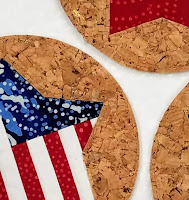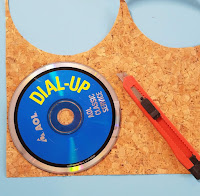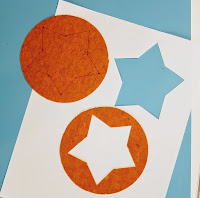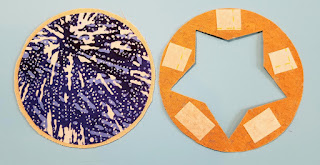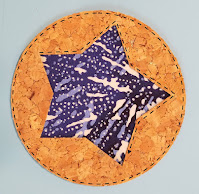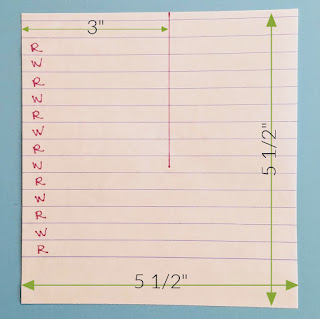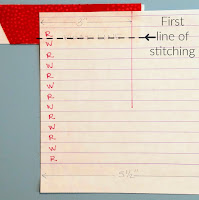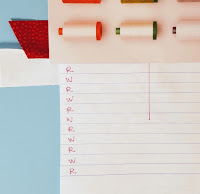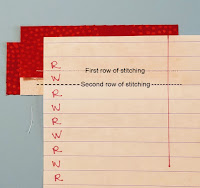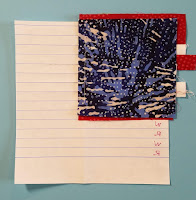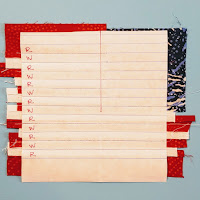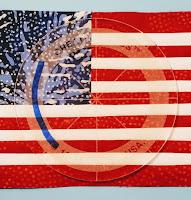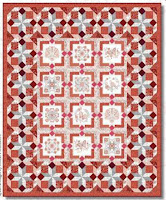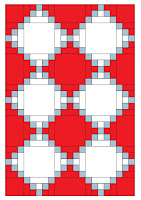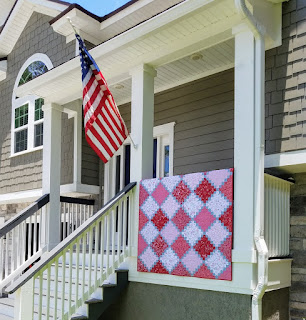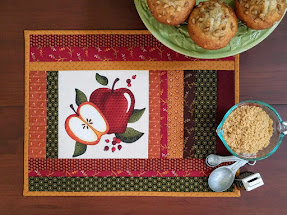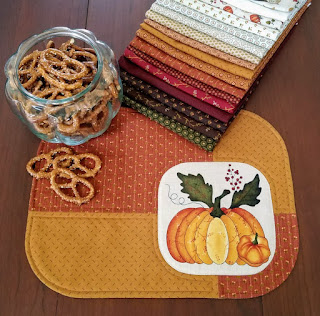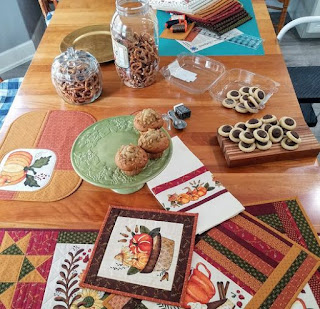Grab a beverage, this post is going to be longer than usual!
A few nights ago I woke up around 3am, thinking about coasters. The kind of coasters that go under your drink, not the kind with thrills and hills. Do not ask me why coasters were so important at 3am. I have no idea why my brain works the way it does. I do know that isn't unusual for me to wake up in the middle of the night and lay awake mentally working through the step-by-step process of sewing something together.
Because the 4th of July is just around the corner, I thought a flag project would be a perfect coaster. I mentally paper pieced the flag part - no problem there. It was how to finish the edges that kept me awake until after 5am.
I didn't want to turn them under. I didn't want to add a binding. Pinked edges seemed too informal. In the wee hours I finally decided that cork might work and promptly went back to sleep.
Oddly enough, I can explain the cork process in just a few steps - and I will in another post. But first you have to foundation paper piece the flag and that explanation is going to take some effort.
Step 1. Draft the pattern. You can do this! The U.S, flag is mostly stripes, so the easiest way to make the pattern is to use a piece of notebook paper. The stripes are built in! Cut a square about 5 1/2" square. The flag has 13 stripes, so mark off 13 rows and mark the rows, alternating Red and White on the left side of the paper. You should begin and end with red. Those 13 stripes should measure around 4 1/2".
Next measure in from the left side 3" and draw a vertical line from the top of the page down past the top 8 rows.
That is it, your pattern is finished!
Time to grab some red, white and blue fabric scraps. Choose a white that is as opaque as possible. You don't want to see those red threads shadowing through. I cut the strips 1 1/4", which is REALLY generous, but I would rather trim than scrimp. I cut the blue square 3 1/2". Once again, SUPER generous, but better too much than too little. After all, we are working with scraps!
Step 2. The process is called foundation paper piecing. You will be working upside down and backwards. This means that you will have fabric on the bottom and your paper pattern will be covering it up. Trust me, it works! Turn the paper pattern over. You will be placing the fabric on the back.
Place one strip of red so that it covers the top right corner, all of the top red stripe and most of the 2nd stripe that is white. The fabric strip should span from about 1/4" over that vertical line on the left to off the paper on the right. This strip should be right side up. I used batiks, so it is difficult to tell the right side from the wrong side.
Now place a strip of white, face down, on top of that red strip. I nudge that white strip a tiny bit over the red fabric, just to make sure the red doesn't show through the white later.
BEFORE YOU SEW, thread your machine with white top and bobbin thread and REDUCE YOUR STITCH LENGTH - a lot.
I reduce my stitch length to 1.0. That puts a ton of stitches in each inch. Those stitches perforate the paper so that it is very easy to remove when the block is complete. The bad news is, if you make a mistake, you have a TON of stitches to rip out!
Hold the fabrics in place as you gently turn the paper over and slide it into your machine. I use a presser foot with a center mark so that it is easy to follow the printed line.
You are ready to sew on the line between the top red row and the second white row. You should see the fabric extending into the row marked white.
Your stitching should be tiny stitches, directly on the line printed on the paper.
Turn the unit over, fabric side up. Open the fabrics and press either with an iron or a wooden press bar. You can trim any excess fabric that extends on the right hand side beyond the paper pattern
Turn the unit over, paper side up. This is where I use a stiff piece of cardstock. I happen to have the ad for Aurifil Thread handy and it worked perfectly. For short seams a postcard or any stiff paper will work well. It helps to have a firm edge to fold the paper against.
Align the paper with the printed line at the BOTTOM of the white stripe. This is where your next stitching line will be. That is where you want to FOLD the paper. Fold the paper back, over the cardstock to reveal the fabric underneath.
Now you can trim the excess fabric. Make sure that you TRIM 1/4" from the fold to allow for seam allowance. You DO NOT want to trim ON the printed line, you want to trim 1/4" past the printed line where you will sew.
Unfold the paper, set the cardstock aside and turn the unit fabric side up. Place another strip of red fabric on top of the white, having the right sides together.
Hold the fabric in place as you turn the unit over and stitch on the second line, at the bottom of the white stripe.
Repeat. Continue adding fabric strips, folding the paper back, trimming and pressing until you have added four red and three white stripes.
You have been adding stripes to the left side of the paper pattern. When the fabric side is face up, the stripes are on the right, where they should be. This is what I meant by upside down and backwards!
The next step is to add the blue section. I used a 3 1/2" square of fabric. Most of that will be cut off and end up in the trash. One thing you learn when foundation paper piecing is that too big is much better than too small! Don't skimp!
Before adding the blue square, gently pull the paper away from the fabric. Use the cardstock to help you fold the paper on the vertical line and trim the excess fabric to create a nice clean edge. Don't forget to leave the 1/4" seam allowance in place!
Place the blue square on top of the red and white stripes having the right sides together and one edge even with the trimmed edge toward the center of the paper. The blue square should extend all the way to the bottom of the last red stripe. Stitch in place by sewing on the vertical line you drew in step 1.
Flip the unit over. Open the blue fabric square and press.
It is starting to look like a flag!
Time to trim the bottom edge and add the next white stripe. This stripe will extend all the way across the pattern.
Keep going! Sew, fold, trim, press, until all of the stripes have been added.
To make the coasters we will be trimming the flag into a circle.
I want you to understand how to finish trimming, just incase you want to make your flag into a square or rectangle.
The left and right edges can be trimmed even with the edge of the paper or they can be trimmed 1/4" away, depending on your desired seam allowance.
The top and bottom edge MUST be trimmed 1/4" ABOVE and BELOW the line printed on the paper. That adds the seam allowance to the top and bottom stripes!
Now you can remove the paper! Simply peel it away.
To make the coasters we will be trimming the flag into a 4 1/2" circle. I have the set of Creative Grids Circle Templates to use. If you don't own circle templates, look around the house for something 4 1/2" round. Find an old CD if you can. Gather up those, your cork and a craft knife and I will post the instructions for assembling the coasters in my next blog post.

